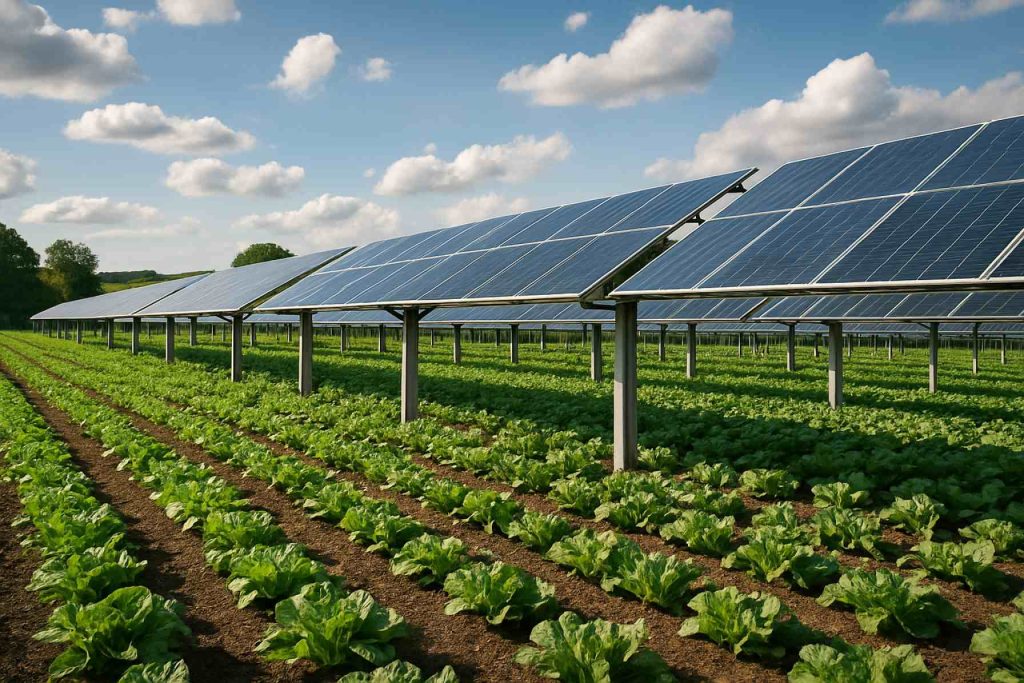
Agrivoltaic Energy Systems Market Report 2025: In-Depth Analysis of Growth, Technology, and Regional Trends. Explore How Dual-Use Solar Solutions Are Transforming Agriculture and Energy Sectors.
- Executive Summary & Market Overview
- Key Technology Trends in Agrivoltaic Energy Systems
- Competitive Landscape and Leading Players
- Market Growth Forecasts (2025–2030): CAGR, Revenue, and Installed Capacity
- Regional Analysis: Adoption Patterns and Key Markets
- Future Outlook: Innovations and Policy Impacts
- Challenges and Opportunities in Agrivoltaic Energy Systems
- Sources & References
Executive Summary & Market Overview
Agrivoltaic energy systems, also known as agrophotovoltaics, represent an innovative approach that combines agricultural production with photovoltaic (PV) solar energy generation on the same land area. This dual-use model addresses the growing global demand for renewable energy while mitigating land-use conflicts between food and energy production. As of 2025, the agrivoltaic market is experiencing accelerated growth, driven by policy support, technological advancements, and increasing awareness of sustainable land management.
According to International Energy Agency (IEA) projections, global solar PV capacity is expected to surpass 2,000 GW by 2025, with agrivoltaic installations accounting for a rising share of new projects, particularly in regions facing land scarcity and high solar irradiance. The market is witnessing significant activity in Europe, Asia-Pacific, and North America, where governments are incentivizing dual-use land strategies to meet climate targets and enhance rural economies.
A 2024 report by Wood Mackenzie estimates the global agrivoltaic market size at approximately $3.6 billion, with a compound annual growth rate (CAGR) exceeding 10% through 2030. Key drivers include the need for efficient land utilization, resilience to climate change, and the potential for increased crop yields under certain PV configurations. For example, research cited by the Fraunhofer Institute for Solar Energy Systems demonstrates that partial shading from solar panels can reduce crop water stress and improve yields for select crops, further enhancing the value proposition of agrivoltaic systems.
- Europe: France, Germany, and Italy are leading the region, with supportive policies and pilot projects scaling to commercial deployments. The European Union’s Green Deal and Common Agricultural Policy reforms are catalyzing investment in agrivoltaics.
- Asia-Pacific: China and Japan are at the forefront, leveraging agrivoltaics to address food security and renewable energy goals. China’s 14th Five-Year Plan includes specific targets for dual-use solar projects.
- North America: The United States is seeing increased interest, particularly in arid states like California and Arizona, where water conservation and land optimization are critical.
Despite strong momentum, the sector faces challenges such as regulatory uncertainty, high initial capital costs, and the need for tailored system designs to suit diverse crops and climates. Nevertheless, the outlook for 2025 remains robust, with agrivoltaic energy systems poised to play a pivotal role in the global transition to sustainable energy and agriculture.
Key Technology Trends in Agrivoltaic Energy Systems
Agrivoltaic energy systems, which integrate photovoltaic (PV) solar panels with agricultural activities on the same land, are rapidly evolving due to several key technology trends anticipated to shape the sector in 2025. These trends are driven by the dual imperatives of maximizing land use efficiency and enhancing both energy and crop yields.
- Advanced Bifacial and Semi-Transparent PV Modules: The adoption of bifacial and semi-transparent solar panels is accelerating. These modules allow sunlight to reach crops below while generating electricity from both sides, improving overall land productivity. Recent field trials have demonstrated that semi-transparent modules can increase crop yields by optimizing light spectra and reducing heat stress, while still delivering competitive energy output (National Renewable Energy Laboratory).
- Dynamic and Adjustable Mounting Structures: Innovations in mounting systems, such as adjustable-height and tiltable racking, enable real-time adaptation to crop growth cycles and seasonal sun angles. These systems can be automated to optimize both shading for crops and solar energy capture, enhancing the economic viability of agrivoltaic projects (Fraunhofer Society).
- Integration of Smart Sensors and IoT: The deployment of Internet of Things (IoT) devices and advanced sensors is enabling precise monitoring of microclimates, soil moisture, and plant health beneath solar arrays. Data-driven management allows for dynamic adjustment of panel orientation and irrigation, leading to improved crop resilience and resource efficiency (International Energy Agency).
- Hybrid Energy and Storage Solutions: Agrivoltaic systems are increasingly being paired with battery storage and other renewable sources (such as wind or biogas) to provide stable, on-site power for farms. This trend supports grid resilience and enables farms to participate in demand response and energy trading markets (Wood Mackenzie).
- Crop-Specific System Design: Research is focusing on tailoring agrivoltaic configurations to specific crops, optimizing panel height, spacing, and transparency to suit the light and temperature needs of different plants. This customization is expected to drive higher adoption rates among farmers by demonstrating tangible agronomic benefits (International Renewable Energy Agency).
These technology trends are positioning agrivoltaic energy systems as a cornerstone of sustainable agriculture and renewable energy strategies in 2025, with ongoing innovation expected to further enhance their performance and scalability.
Competitive Landscape and Leading Players
The competitive landscape of the agrivoltaic energy systems market in 2025 is characterized by a dynamic mix of established solar energy companies, agricultural technology innovators, and emerging startups. The sector is witnessing increased collaboration between photovoltaic (PV) manufacturers and agricultural enterprises, aiming to optimize land use and maximize both energy and crop yields. This convergence is driving rapid technological advancements and strategic partnerships.
Leading players in the global agrivoltaic market include BayWa r.e., a German renewable energy developer that has pioneered large-scale agrivoltaic projects across Europe, particularly in France and the Netherlands. The company’s “Agri-PV” solutions integrate bifacial solar panels with crop cultivation, demonstrating significant improvements in land productivity and farmer income. Another major player, Enel Green Power, has expanded its agrivoltaic portfolio in Italy and Spain, focusing on research-driven pilot projects that assess the impact of solar installations on diverse crop types.
In Asia, Sharp Corporation and Trina Solar are at the forefront, leveraging their expertise in solar module manufacturing to develop tailored agrivoltaic solutions for rice paddies and orchards in Japan and China. These companies are investing in R&D to address region-specific challenges such as shading optimization and water management.
Startups and specialized firms are also shaping the competitive landscape. France-based Sun’Agri has developed dynamic solar tracking systems that adjust panel angles in real time to balance sunlight for crops and energy generation. In the United States, BlueWave is notable for its community-focused agrivoltaic projects, partnering with local farmers to deploy dual-use solar arrays.
- Strategic alliances between energy and agricultural firms are accelerating market penetration, as seen in joint ventures and co-development agreements.
- Government-backed pilot programs in the EU, Japan, and the US are fostering innovation and providing a platform for new entrants.
- Competition is intensifying around proprietary technologies, such as adjustable mounting systems and crop-specific PV designs.
Overall, the agrivoltaic energy systems market in 2025 is marked by a blend of established renewable energy leaders and agile innovators, with regional players adapting solutions to local agricultural practices and regulatory frameworks.
Market Growth Forecasts (2025–2030): CAGR, Revenue, and Installed Capacity
The global agrivoltaic energy systems market is poised for robust growth between 2025 and 2030, driven by increasing demand for sustainable energy solutions and the dual benefits of land use for both agriculture and solar power generation. According to projections by the International Energy Agency (IEA), the installed capacity of agrivoltaic systems is expected to expand at a compound annual growth rate (CAGR) of approximately 12% during this period. This growth is underpinned by supportive government policies, technological advancements in bifacial and semi-transparent photovoltaic modules, and the rising need to optimize land resources in regions facing agricultural and energy production constraints.
Revenue forecasts for the agrivoltaic sector reflect this upward trajectory. Market research from MarketsandMarkets estimates that global agrivoltaic system revenues will reach nearly USD 7.5 billion by 2030, up from an estimated USD 3.2 billion in 2025. This surge is attributed to large-scale pilot projects transitioning to commercial deployment, particularly in Europe, East Asia, and North America, where policy incentives and land scarcity are most pronounced.
Installed capacity is projected to surpass 25 GW by 2030, a significant leap from the estimated 10 GW in 2025, as reported by the International Renewable Energy Agency (IRENA). China, France, and Japan are expected to lead in new installations, with emerging markets in India and the United States accelerating adoption through public-private partnerships and rural development programs.
- Europe: The European Union’s Green Deal and Common Agricultural Policy reforms are expected to drive a CAGR of over 13% in the region, with France and Germany at the forefront of agrivoltaic integration.
- Asia-Pacific: China and Japan are scaling up pilot projects to commercial scale, with China targeting over 5 GW of new capacity by 2030.
- North America: The U.S. Department of Energy’s investments in dual-use solar projects are projected to boost the region’s market share, with a CAGR of 11% through 2030.
Overall, the 2025–2030 period is set to witness accelerated growth in agrivoltaic energy systems, with market expansion driven by policy support, technological innovation, and the imperative to maximize land productivity for both food and energy security.
Regional Analysis: Adoption Patterns and Key Markets
The adoption of agrivoltaic energy systems—integrating solar photovoltaic (PV) panels with agricultural activities—varies significantly across regions, shaped by policy frameworks, land use pressures, and climate conditions. In 2025, the Asia-Pacific region, Europe, and North America emerge as the primary markets driving growth and innovation in agrivoltaics.
Asia-Pacific leads global adoption, propelled by land scarcity and ambitious renewable energy targets. International Energy Agency data highlights China and Japan as frontrunners, with large-scale pilot projects and government incentives. Japan’s “Solar Sharing” program, for instance, has enabled over 2,000 agrivoltaic installations by 2024, supporting both food security and decarbonization. India is also scaling up, with the Ministry of New and Renewable Energy promoting agrivoltaics under the KUSUM scheme to enhance farmer incomes and rural electrification.
Europe is characterized by robust policy support and integration into the European Green Deal. France and Germany are at the forefront, with the French government’s 2023 regulatory framework clarifying land use and grid access for agrivoltaic projects. According to Fraunhofer Institute, Germany’s installed agrivoltaic capacity surpassed 200 MW in 2024, with a focus on high-value crops and climate adaptation. Southern European countries, such as Italy and Spain, are rapidly expanding pilot projects, leveraging EU funding to address drought resilience and rural development.
- France: Over 100 MW of agrivoltaic capacity installed by 2024, with a pipeline of large-scale projects targeting fruit and vegetable farms (ADEME).
- Germany: Focus on research-driven deployment, with demonstration sites evaluating crop yields and biodiversity impacts (Fraunhofer Institute).
North America is witnessing growing interest, particularly in the United States, where the National Renewable Energy Laboratory reports over 50 MW of operational agrivoltaic projects by 2024. Adoption is concentrated in states with strong solar incentives and water scarcity concerns, such as California and Arizona. Canada is in earlier stages, with pilot projects exploring cold-climate applications.
In summary, regional adoption patterns in 2025 reflect a convergence of policy support, land use optimization, and climate adaptation needs, with Asia-Pacific, Europe, and North America leading the global agrivoltaic market.
Future Outlook: Innovations and Policy Impacts
The future outlook for agrivoltaic energy systems in 2025 is shaped by a convergence of technological innovation and evolving policy frameworks. Agrivoltaics—the dual use of land for both solar photovoltaic energy generation and agriculture—has gained momentum as a solution to land-use conflicts and as a means to enhance rural economic resilience. In 2025, several key trends are expected to drive the sector’s growth and transformation.
On the innovation front, advancements in solar panel design and system integration are enabling more efficient coexistence of crops and energy production. Semi-transparent and adjustable solar modules, for example, are being deployed to optimize light distribution for various crop types, improving yields while maintaining high energy output. Companies such as Enel Green Power and BayWa r.e. are piloting large-scale agrivoltaic projects in Europe and North America, demonstrating the commercial viability of these systems. Additionally, digital monitoring tools and AI-driven analytics are being integrated to manage microclimates and maximize both agricultural and energy productivity.
Policy impacts are equally significant. In 2025, governments in the European Union, United States, and parts of Asia are expected to expand incentives for agrivoltaic installations. The European Commission’s REPowerEU plan, for instance, includes provisions to streamline permitting and provide financial support for dual-use solar projects. In the U.S., the Department of Energy’s Solar Energy Technologies Office is funding research and demonstration projects to accelerate agrivoltaic adoption, with a focus on rural and underserved communities.
Looking ahead, the interplay between innovation and policy is expected to lower costs, improve system performance, and address regulatory barriers. However, challenges remain, including the need for standardized guidelines, long-term impact studies on soil health and crop diversity, and the development of business models that equitably benefit farmers and energy developers. As these issues are addressed, agrivoltaic energy systems are poised to become a mainstream component of sustainable land management and renewable energy strategies by the end of the decade.
Challenges and Opportunities in Agrivoltaic Energy Systems
Agrivoltaic energy systems, which integrate photovoltaic (PV) solar panels with agricultural activities on the same land, present a dynamic intersection of renewable energy generation and food production. As the global demand for both clean energy and sustainable agriculture intensifies, agrivoltaics are gaining traction as a promising solution. However, the sector faces a unique set of challenges and opportunities as it moves into 2025.
Challenges
- Technical Integration: Achieving optimal coexistence between crops and solar panels requires careful system design. Factors such as panel height, tilt, and spacing must be tailored to local crop types and climatic conditions. Inadequate design can lead to reduced crop yields or suboptimal energy production, as highlighted by International Energy Agency research.
- Economic Viability: The initial capital costs for agrivoltaic installations are higher than for conventional solar farms due to the need for specialized mounting structures and dual-use planning. According to Wood Mackenzie, the payback period can be longer unless supported by government incentives or premium pricing for dual-use land.
- Regulatory Barriers: Land use regulations and zoning laws in many regions do not yet accommodate or recognize agrivoltaic systems, creating uncertainty for project developers. The National Renewable Energy Laboratory notes that policy frameworks often lag behind technological advancements, impeding large-scale adoption.
- Operational Complexity: Managing both agricultural and energy operations on the same site requires new skill sets and collaboration between farmers and energy companies, which can be a barrier in regions with limited technical expertise.
Opportunities
- Land Use Efficiency: Agrivoltaics can significantly increase land productivity by generating both food and energy from the same acreage. This is particularly valuable in regions facing land scarcity or competing land-use demands, as emphasized by Food and Agriculture Organization of the United Nations.
- Climate Resilience: Solar panels can provide partial shading, reducing crop heat stress and water evaporation. Studies by the Fraunhofer Institute for Solar Energy Systems show improved yields for certain crops under agrivoltaic systems, especially in arid and semi-arid climates.
- Policy Momentum: Growing recognition of agrivoltaics’ potential is prompting new policy support in the EU, US, and Asia. Incentives, pilot programs, and research funding are expected to accelerate deployment in 2025, according to IEA Photovoltaic Power Systems Programme.
- Community and Economic Benefits: Agrivoltaic projects can diversify farm income, create rural jobs, and enhance energy access, supporting broader sustainability and rural development goals.
Sources & References
- International Energy Agency (IEA)
- Wood Mackenzie
- Fraunhofer Institute for Solar Energy Systems
- National Renewable Energy Laboratory
- BayWa r.e.
- Enel Green Power
- Trina Solar
- Sun’Agri
- MarketsandMarkets
- Ministry of New and Renewable Energy
- REPowerEU
- Food and Agriculture Organization of the United Nations



